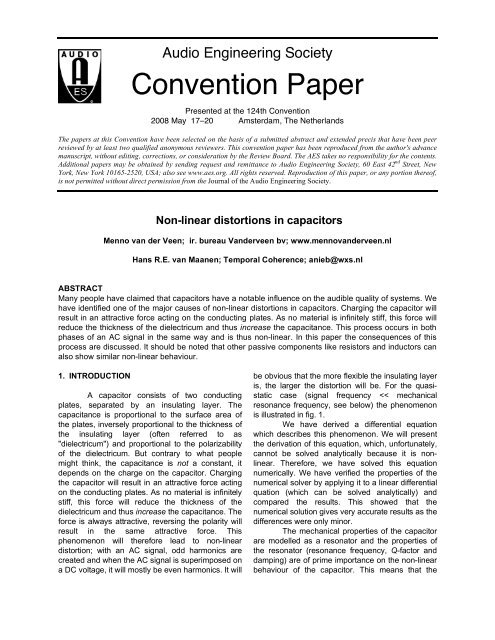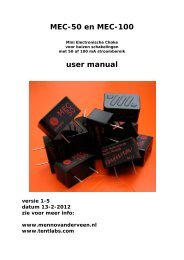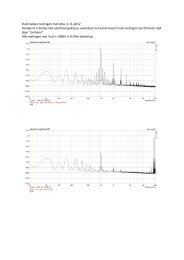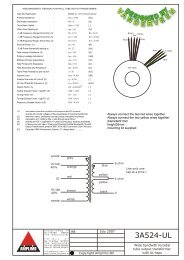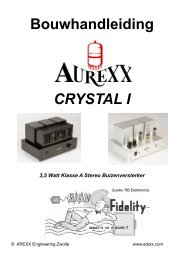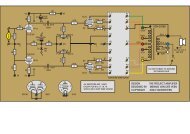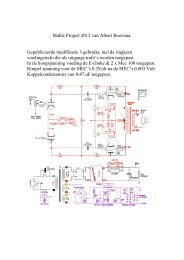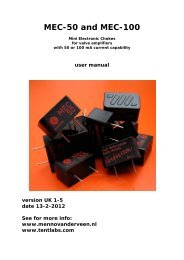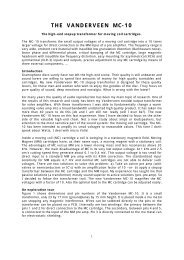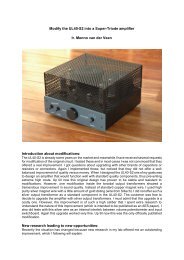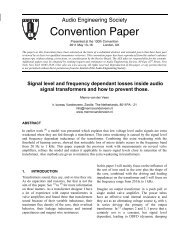AES 124-paper - Menno van der Veen
AES 124-paper - Menno van der Veen
AES 124-paper - Menno van der Veen
- No tags were found...
Create successful ePaper yourself
Turn your PDF publications into a flip-book with our unique Google optimized e-Paper software.
Audio Engineering SocietyConvention PaperPresented at the <strong>124</strong>th Convention2008 May 17–20 Amsterdam, The NetherlandsThe <strong>paper</strong>s at this Convention have been selected on the basis of a submitted abstract and extended precis that have been peerreviewed by at least two qualified anonymous reviewers. This convention <strong>paper</strong> has been reproduced from the author's ad<strong>van</strong>cemanuscript, without editing, corrections, or consi<strong>der</strong>ation by the Review Board. The <strong>AES</strong> takes no responsibility for the contents.Additional <strong>paper</strong>s may be obtained by sending request and remittance to Audio Engineering Society, 60 East 42 nd Street, NewYork, New York 10165-2520, USA; also see www.aes.org. All rights reserved. Reproduction of this <strong>paper</strong>, or any portion thereof,is not permitted without direct permission from the Journal of the Audio Engineering Society.Non-linear distortions in capacitors<strong>Menno</strong> <strong>van</strong> <strong>der</strong> <strong>Veen</strong>; ir. bureau Van<strong>der</strong>veen bv; www.menno<strong>van</strong><strong>der</strong>veen.nlHans R.E. <strong>van</strong> Maanen; Temporal Coherence; anieb@wxs.nlABSTRACTMany people have claimed that capacitors have a notable influence on the audible quality of systems. Wehave identified one of the major causes of non-linear distortions in capacitors. Charging the capacitor willresult in an attractive force acting on the conducting plates. As no material is infinitely stiff, this force willreduce the thickness of the dielectricum and thus increase the capacitance. This process occurs in bothphases of an AC signal in the same way and is thus non-linear. In this <strong>paper</strong> the consequences of thisprocess are discussed. It should be noted that other passive components like resistors and inductors canalso show similar non-linear behaviour.1. INTRODUCTIONA capacitor consists of two conductingplates, separated by an insulating layer. Thecapacitance is proportional to the surface area ofthe plates, inversely proportional to the thickness ofthe insulating layer (often referred to as"dielectricum") and proportional to the polarizabilityof the dielectricum. But contrary to what peoplemight think, the capacitance is not a constant, itdepends on the charge on the capacitor. Chargingthe capacitor will result in an attractive force actingon the conducting plates. As no material is infinitelystiff, this force will reduce the thickness of thedielectricum and thus increase the capacitance. Theforce is always attractive, reversing the polarity willresult in the same attractive force. Thisphenomenon will therefore lead to non-lineardistortion; with an AC signal, odd harmonics arecreated and when the AC signal is superimposed ona DC voltage, it will mostly be even harmonics. It willbe obvious that the more flexible the insulating layeris, the larger the distortion will be. For the quasistaticcase (signal frequency
Van <strong>der</strong> <strong>Veen</strong> et. al.Non-Linear distortions in capacitors4. NUMERICAL SOLUTIONSWith the differential equation 3 and theelectrical circuit equations 4 to 6 a set of differentialequations is created which needs to be solved.However, the total system is non-linear, so astandard analytical solution is not applicable.Therefore we developed a numerical approach,which is discussed below.Because of space limitations, we will onlygive a course outline of the numerical solver. It is awell-established solving technique using timediscretisation and no voltage and currentdiscretisations. The pitfall is that the timediscretisation introduces delays between thedifferent <strong>der</strong>ivatives (first and second or<strong>der</strong>) andthus a deviation between the analytical andnumerical differential equations which are solved.The obvious solution is to use very small timesteps, but this can lead to a large volume ofcalculations and –far more sneaky- to round-offerrors in the changes of the signal to benumerically integrated. This will lead to erroneousresults. Finding the correct balance between thetwo conflicting requirements is part of the solverand this has been verified by applying the solver toa linear second or<strong>der</strong> differential equation (whichcan be solved analytically) and subsequentlycomparing the analytical and numerical solutions.The results of this verification are presented infigures 2 and 3 and it is clear that the results areindistinguishable. The results of the solver can betrusted such that it will provide the consequencesof the non-linear effects as the model introduces.5. RESULTS AND DISCUSSIONWhen a sine wave is sent through thehigh-pass filter as mentioned above, the value ofthe swinging capacitor will vary with the voltageacross the capacitor. As a consequence, thecurrent, flowing through the load resistor R L will notbe a pure sine wave, but will be –relativelyspeaking- larger when the voltage across thecapacitor is larger. An extreme case, in which theplate distance variation equals 3.5 %, was chosento illustrate the effect as the distortion in the currentis visible without further analysis. It also shows thatthe phase of the distortion products is influencedby the phase across the capacitor. Note that the“cut-off” frequency is no longer a constant as thecapacitance is not a constant!When an AC signal is applied to such afilter, the distortion products are –as a firstapproximation- proportional to the square of theinput voltage. This means that the effects increasestrongly with the signal strength. As it is likely thatthere will be a relation with the maximum voltage acapacitor can handle. the effects are likely to bestrong in passive cross-over loudspeaker filterswhere strong signals are used.6. INTERMODULATION IN CROSS-OVERFILTERSThe non-linear properties as outlinedabove become apparent in cross-over filters wheremostly large AC signals are applied in combinationwith large capacitors (both in capacitance and size)because of the large currents which flow through it,compared to e.g. the electronics in a controlamplifier. Such capacitors will –in general- showthe non-linear behaviour clearly and it is thereforenot really surprising that cross-over filters are oftenmentioned when the audible properties ofcapacitors are discussed. Therefore a typical casewas modelled: two pure sine waves were used asinput signal. The frequency of the high frequencywas roughly equal to the cut-off frequency of thehigh-pass filter, the frequency of the low frequencycomponent is 1/8 of the frequency of the highfrequency component and its amplitude is 4 timesthe amplitude of the high frequency component.The initial input frequencies can be identified atfrequencies “1” and “8” in figure 5. Note that theamplitude of the low-frequency signal has beenreduced as can be expected by the action of ahigh-pass filter. The results, presented in fig. 5, canbe called stunning. Although the calculation isbased on the model as presented above, the clearpresence of a large number of intermodulationproducts with a significant signal strength isworrying to say the least. It is obvious that sucheffects can clearly introduce audible differencesbetween different types of capacitors. But now thatwe have unveiled the un<strong>der</strong>lying cause of theproblem, an objective way to determine the audibleproperties of different types of capacitors can be<strong>AES</strong> <strong>124</strong>th Convention, Amsterdam, The Netherlands, 2008 May 17–20Page 3 of 7
Van <strong>der</strong> <strong>Veen</strong> et. al.Non-Linear distortions in capacitorsdeveloped. The choice of the dielectricum and theway the capacitor is constructed can now also beoptimised.The results, presented in figs 4 and 5 areobtained at frequencies an or<strong>der</strong> of magnitudebelow the mechanical resonance frequency of thecapacitor. When the frequency of the input signalis (far) above the resonance frequency of thecapacitor, the movement of the plates cannotfollow the input signal and therefore the effects willbe small, compared to those below the resonancefrequency. The higher the ratio of the inputfrequency and the resonance frequency, thesmaller the effects are.When the frequency of the input signal isclose to the resonance frequency, the movementof the plates is enhanced and so are the effects.Predicting these effect is, however, severelyhampered by the lack of knowledge of theproperties of this resonance, especially the Q-factor and therefore it is –at this moment- notopportune to present results as these could beseverely different from reality. This will requireexperiments to determine the properties of theresonance. However, as it is not unlikely thatespecially capacitors, used for passive cross-overfilters, will resonate in the audio-band, the choiceof the capacitor and the cut-off frequency cangreatly influence the audible quality.Capacitors, used in electronics, like inamplifiers and active cross-over filters, often havea DC component across the plates. This willchange the properties of the distortion products:un<strong>der</strong> such conditions, the distortion products willbe mainly even harmonics, albeit that in this casethe distortion is proportional to the AC signalstrength as long as the peak-to-peak value of theAC component is smaller than the DC voltage. Butas the signals are usually smaller than in passivecross-over filters, the distortions will be smaller aswell. Still, the design of such electronics can beoptimised with the properties of the capacitors inmind.Other passive components like resistorsand inductors also show non-linear behaviour. In aresistor, the momentary, instantaneous, dissipationis proportional to the square of the current. Thedissipation will increase the temperature and –ingeneral- also the resistance of the resistor. Thisresults in similar phenomena as described for thecapacitor, but in reality, the effect will be minorbecause of the thermal inertia of the resistor: thevariations in the dissipation will –in many cases- betoo fast to change the temperature of the materialfrom which the resistor is made notably. Anexception could be when low frequencies areinvolved and / or with thin film resistors.Inductors can show non-linear effects intwo ways: first of all when a core is present due tothe non-linear relation between the magneticproperties of the core and the magnetic field, andsecondly because of forces, acting on the coil asthe current flowing through the inductor will changeits physical dimensions, which is, similar as in thecase of a capacitor, invariant for inverting the signof the current. Both will influence the inductance ina non-linear way and thus create distortions,similarly as occur in capacitors, as described in thisarticle.7. CONCLUSIONSWe have discovered a major cause of nonlineardistortion in capacitors and we have shownthat this effect can create significant –and thusaudible- distortions in sound signals. Especially inpassive cross-over filters this effect can introducehigh levels of intermodulation distortion and thuslead to audible differences between capacitors.The un<strong>der</strong>lying causes of these distortionshave now been unveiled and therefore, anobjective way to determine the audible quality ofcapacitors can be developed. This is a major stepforward, compared to endless listening tests withoften incomprehensible results. Also, the design ofelectronics can be optimised with the non-linearproperties of capacitors as parameter.8. REFERENCES[1] Cyril Bateman: "Capacitor Sound?";Electronics World, July 2002 to September 2003[2] <strong>Menno</strong> <strong>van</strong> <strong>der</strong> <strong>Veen</strong>: "Low level audio signaltransfer through transformers conflicts withpermeability behavior inside their cores", 122nd<strong>AES</strong> convention 2007, <strong>paper</strong> 7125<strong>AES</strong> <strong>124</strong>th Convention, Amsterdam, The Netherlands, 2008 May 17–20Page 4 of 7
Van <strong>der</strong> <strong>Veen</strong> et. al.Non-Linear distortions in capacitorsFigure 1: The basic phenomenon which creates the non-linear effect in capacitors<strong>AES</strong> <strong>124</strong>th Convention, Amsterdam, The Netherlands, 2008 May 17–20Page 5 of 7
Van <strong>der</strong> <strong>Veen</strong> et. al.Non-Linear distortions in capacitorsFigure 2: The response of a linear mechanical resonator to a sine wave, which starts at t = 0. Analyticalsolution of the differential equation.Figure 3: The response of a linear mechanical resonator to a sine wave, which starts at t = 0. Numericalsolution of the differential equation.<strong>AES</strong> <strong>124</strong>th Convention, Amsterdam, The Netherlands, 2008 May 17–20Page 6 of 7
Van <strong>der</strong> <strong>Veen</strong> et. al.Non-Linear distortions in capacitorsFigure 4: The current, flowing out of the capacitor is no longer a pure sine wave because of the changingof the capacitance due to the voltage across the capacitor.Figure 5: The spectrum of the output signal, clearly showing the intermodulation products. For moredetails, see text.<strong>AES</strong> <strong>124</strong>th Convention, Amsterdam, The Netherlands, 2008 May 17–20Page 7 of 7


